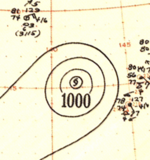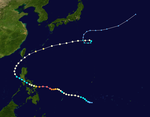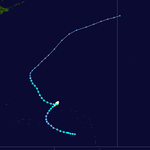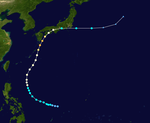1951 Pacific typhoon season
| 1951 Pacific typhoon season |
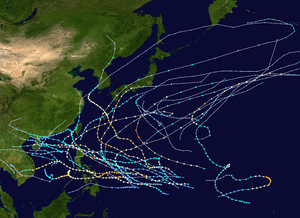
Season summary map
|
| Seasonal boundaries |
| First system formed |
February 19, 1951 |
| Last system dissipated |
December 16, 1951 |
| Strongest storm |
|
| Name |
Marge |
| • Maximum winds |
185 km/h (115 mph)
(1-minute sustained) |
| • Lowest pressure |
886 hPa (mbar) |
|
| Seasonal statistics |
| Total depressions |
31 |
| Total storms |
25 |
| Typhoons |
16 |
| Super typhoons |
1 (unofficial) |
| Total fatalities |
1,185 (including missing and injured)
|
| Total damage |
$106.15 million (1951 USD) |
| Related articles |
|
|
Pacific typhoon seasons
1949, 1950, 1951, 1952, 1953
|
| Tropical storm (JMA) |
|
|
| Duration |
February 19 – February 21 |
| Peak intensity |
65 km/h (40 mph) (10-min) 990 hPa (mbar) |
| Category 4 typhoon (SSHWS) |
|
|
| Duration |
March 18 – March 27 |
| Peak intensity |
220 km/h (140 mph) (1-min) 970 hPa (mbar) |
| Category 1 typhoon (SSHWS) |
|
|
| Duration |
April 15 – April 23 |
| Peak intensity |
130 km/h (80 mph) (1-min) 980 hPa (mbar) |
| Category 5 super typhoon (SSHWS) |
|
|
| Duration |
April 28 – May 13 |
| Peak intensity |
280 km/h (175 mph) (1-min) 909 hPa (mbar) |
| Category 1 typhoon (SSHWS) |
|
|
| Duration |
May 6 – May 13 |
| Peak intensity |
140 km/h (85 mph) (1-min) 980 hPa (mbar) |
| Tropical depression (CMA) |
|
|
| Duration |
May 12 – May 14 |
| Peak intensity |
55 km/h (35 mph) (10-min) 998 hPa (mbar) |
| Tropical storm (CMA) |
|
|
| Duration |
June 17 – June 22 |
| Peak intensity |
75 km/h (45 mph) (10-min) 992 hPa (mbar) |
| Category 3 typhoon (SSHWS) |
|
|
| Duration |
June 26 – July 2 |
| Peak intensity |
185 km/h (115 mph) (1-min) 975 hPa (mbar) |
| Severe tropical storm (JMA) |
|
|
| Duration |
June 30 – July 5 |
| Peak intensity |
95 km/h (60 mph) (10-min) 992 hPa (mbar) |
The 1951 Pacific typhoon season was a generally below average season with multiple tropical cyclones striking the Philippines. With the exception of January, each month saw at least one tropical system develop; October was the most active month with four tropical cyclones forming. Overall, there were 21 tropical depressions, of which 17 became named storms; of those, there were 16 typhoons.
The season began with the formation of a short-lived unnamed tropical storm on February 19, well east of the Philippines; Typhoon Georgia became the season's first named storm and typhoon after first developing in the open Pacific on March 20. In April, Typhoon Iris developed before intensifying into a super typhoon the following month; Iris was the first recorded instance of a Category 5-equivalent typhoon in the western Pacific. The final typhoon and storm of the year was Typhoon Babs, which remained at sea before dissipating on December 17.
The scope of this article is limited to the Pacific Ocean, north of the equator and west of the International Date Line. Storms that form east of the date line and north of the equator are called hurricanes; see 1951 Pacific hurricane season. At the time, tropical storms that formed within this region of the western Pacific were named and identified by the United States Fleet Weather Center in Guam. However, the Japan Meteorological Agency (JMA), which was established five years later, identified four additional tropical cyclones during the season not tracked by the Fleet Weather Center; these analyzed systems did not receive names.
At 0600 UTC on February 19, a tropical cyclone developed well east of the Philippines and began to track northeastward. Late on February 20, the tropical cyclone reached its peak intensity with a minimum central pressure of 990 mbar (hPa; 29.23 inHg) shortly before becoming extratropical; the consequent extratropical cyclone continued to strengthen before dissipating on February 21. This cyclone was not operationally tracked by the Guam Fleet Weather Center, and as such was added to the season by the Japan Meteorological Agency in 1990.
...
Wikipedia




